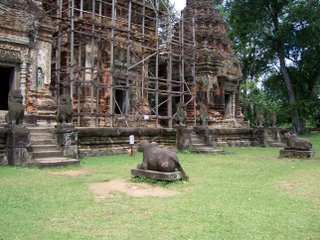 Nandi the bull and mount of Lord Shiva guarding the entrance to Preah Koh, Roluos Group
Nandi the bull and mount of Lord Shiva guarding the entrance to Preah Koh, Roluos Group
Next on the list, we went to the Bakong Temple complex, the early Angkor style of architecture is seen here. Built again by Indravarman I in the late 9th Century, this style prevails throughout the Angkor empire in all complexes built later on. The main temple tower is tall, built high up and this tower (gopura as it is called) is again meant to resemble Mount Meru, considered holy in Hindu mythology.
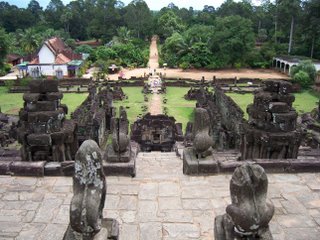 View from top of the Bakong tower looking towards the entrance to the complex and the moat
View from top of the Bakong tower looking towards the entrance to the complex and the moat
 Bakong Temple, early Khmer style gopura architecture
Bakong Temple, early Khmer style gopura architecture
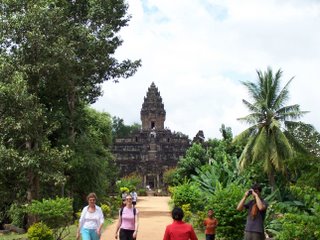 Bakong Temple from the entrance
Bakong Temple from the entrance
Last stop in the Roluos group was Lolei, a small complex of brick construction in very dilapidated condition, supported by thick wooden pillars and supports to prevent the entire structure from falling.
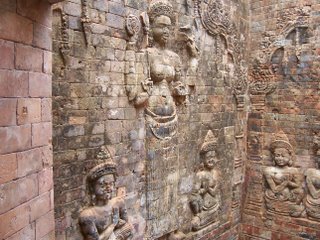 Depiction of Vishnu at Prasat Kravan, all clay brick carvings!
Depiction of Vishnu at Prasat Kravan, all clay brick carvings! The stucco covering remaining on a small part of the brick work at Prasat Kravan
The stucco covering remaining on a small part of the brick work at Prasat Kravan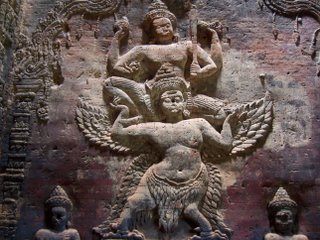 Depiction of Vishnu riding on Garuda, his vehicle, again made of clay bricks at Prasat Kravan
Depiction of Vishnu riding on Garuda, his vehicle, again made of clay bricks at Prasat Kravan Maheshwara, looking like a Lord of the universe, with representation of the 108 original hindu clans behind him, again made of clay bricks atPrasat Kravan
Maheshwara, looking like a Lord of the universe, with representation of the 108 original hindu clans behind him, again made of clay bricks atPrasat Kravan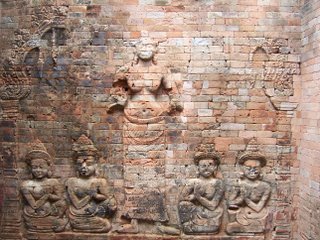 Depiction of Goddess Lakshmi, goddess of wealth, made of clay bricks at Prasat Kravan
Depiction of Goddess Lakshmi, goddess of wealth, made of clay bricks at Prasat KravanComing back towards Siem Reap and with less than half a day to spare and all worn out, we stopped at Bantey Kdei, a typical Angkorean architecture complex built during Jayavarman the VII sometime in the 12th-13th Centruy C.E.
Opposite Bantei Kdei’s entrance is the Srah Srang, a huge man made lake (700 metersX350 meters) that reportedly has had water in it for more than 900 years! This man made lake was actually the swimming pool built first in the late 10th Century during Rajendravarman’s time and possibly remodeled during Jayavarman VII. The inscriptions on the rocks give the details that this was meant as a pool for all creatures except Elephants. Maybe they had a bath somewhere else! It is typical for travelers to this area to end the day watching the sun set over Srah Srang. Typically we then head back to the hotel, a shower later, we are all making a bee line for Pub Street for some local beer and food.
 King's swimming pool at Srah Srang
King's swimming pool at Srah SrangThe next day we went really out of town, the farthest that we had been out of Siem Reap, venturing out to the Phnom Kulen Mountains. These mountains are the origins of the Khmer rulers because it is here that they started their revolution of sorts. Cambodia and the Khmer people had been ruled by the Java Kingdom and early Khmer rulers overthrew them and came down to the plains to rule Cambodia and the rest, as they say, is history and the rich legacy they left behind in the form of all these innumerable temples and complexes. Up in the mountains, there is a stream that contains a thousand lingas (manifestation of Shiva) and also carvings on the stone river bed of Vishnu, goddess Lakshmi and Brahma the creator of the universe. This stream that ends up as a river is still called as a holy river because of the carvings of deities on the river bed. In the dry season, one can take pictures of it, but since we had caught the tail end of the wet season, the water was a bit too deep. While we could clearly see the carvings, it was tough to take pictures.
The stream ends up as a waterfall a little distance away and people stand under the falls to take a dip in the holy water. Phnom Kulen also has a large Buddha carved out of the top of a natural granite boulder. The Buddha is in a reclining position and they have built a temple on top of the boulder enclosing the carving.
We came down to the foot of the mountains for some lunch and we tried vegetarian Khmer style curry made and served in a coconut accompanied by some white sticky rice. Heaven is best described (by me!) as a place where one can eat good curry cooked and served in a coconut with the coconut meat still inside and eaten along with the curry, if one wishes!
Not wanting to waste time at pub street this early in the evening, we decided to drive to the Ton Le Sap Lake, the largest fresh water lake in Asia and take a boat cruise. This is a very interesting part of the trip, not having to see any temples and a good way to end the trip looking at how the local people live. The Ton Le Sap supports a population of boat people. I mean a whole village floats on the lake, I’m not kidding. We went past floating homes, floating schools, even a church, post office and administrative buildings.
Somewhere along the way, the village is separated by Cambodians and a floating village of Vietnamese people! It’s so weird. Anyway, the floating homes have dogs, cats and even floating pig pens. This is a ‘must see’ for anyone who wants to see how people live around here. It is an eye opener, the people living on the lake, washing in it, bathing in it, cooking with it and so on. The people here are of limited means and when you see them living such simple lives, one’s eyes really open to what’s going on in the World and how we think we have it so good. We ended the day drinking Angkor beer (what else?) on a floating restaurant that had some crocodiles breeding on site (it gets weirder, doesn’t it?).
 Floating Village on the Ton Le Sap
Floating Village on the Ton Le Sap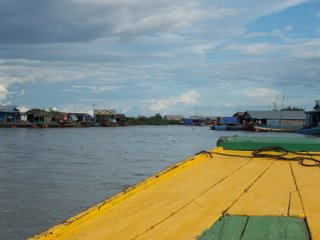
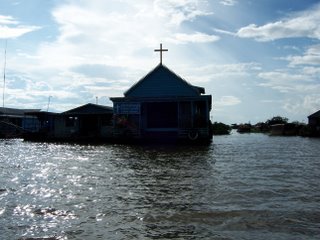 Floating Church (left) and house (below)
Floating Church (left) and house (below)
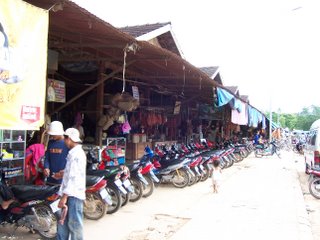
Pictures of the old market where one can bargain for local handicrafts and a place to browse
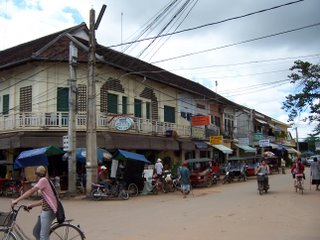
It would be shame to say that this is all about Cambodia, because it isn’t. While we covered most of the talked about sites and ones that the hordes of tourists don’t visit, we still have to go back to Cambodia. There’s still Phnom Penh, the capital city, to see. There’s still Sihanoukville to hang out, with its pristine (at least for now I heard) white sandy beaches in the Gulf of Thailand and maybe I’d also discover an unseen temple complex in the jungle like Indiana Jones. Maybe it will be the dry season and we’d be able to take the balloon up over the Angkor Wat complex, now that would be a sight. I’m really looking forward to the time that I can go back. This was my first trip there, for sure not my last!
Thanks for reading and hope you were able to travel through Siem Reap, Angkor Kingdom and through time with me on this trip. I'll try and post some pictures of us in Cambodia in a different topic. Watch for them!
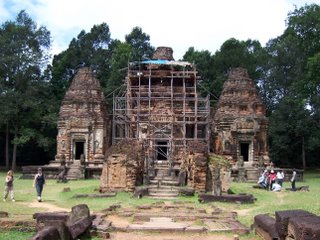
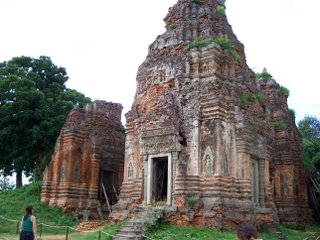
6 comments:
Awesome. I hope to go there one day. You give a great description!
Thanks Quodlibet. I should have posted the article sooner because my memory would be fresher, not that I have forgotten anything but sometimes, there are small but interesting impressions that I may miss when I write about a month or so later.
If you plan on going there, try not to go in the touristy high season (Nov-Mar)and try and make it in the lean season, sometime before the monsoon (be prepared for hot and humid weather) or the end of the monsoon period. Thats what we did and it was somewhat pleasant during the tail end of the monsoon with plenty of water in all water bodies, everything looking green and thats a nice experience. It may rain on and off during this period but not heavy enough to stop you from going out, for me an umbrella did the trick.
Lean season also gives you empty hotel rooms, cheaper rates (even air fares are cheaper)and uncongested sites. In the dry season (high season) hordes of tourists throng the sites, I have been told.
Hey capt. Murty! Phew! I missed so much material on your blog in my busy days (although it was just two posts). But, I went through both the posts! That was an amazing experience... just to read the posts. I wonder how exciting it will be to be there!
Anyway... my flight competition got done with couple of weeks ago. Here are some pics...
We were lucky enough to have an F-18 come in during the competition.. and unlcuky enough to have a mid-air collsion (non-fatal, no injuries.)
http://www.flickr.com/photos/69984524@N00/
Will edit the barrage of videos and send that to you too...
Thanks Nikhil. I am on the road again, in goa for a couple of days on some personal matters. I'll be back at base in Singapore next monday.
Yet another intresting blog from ur side . intresting narration of the place , it was nice reading it .
floating village is a must see i feel .
Thanks for sharing useful information to us. I will visit Siem Reap soon and hope will have a great time! you can get a lot of useful info from this travel guide www.a4trip.com :)
Post a Comment